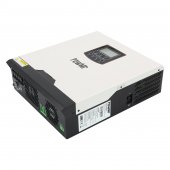first class coatings
New Member
- Joined
- Jan 7, 2021
- Messages
- 14
Hi Forum:::
A forum member posted this, which sparked me to think of a few factors...
Based on this comment: - In general I get at most about 1400 watts out of the panels at peak (they are not an ideal facing but it's the best I can do on my property).
MY QUESTION: I have a powmr brand mppt hybrid inverter 3kw - 24 volt lead acid batttery set up...
I have 8 - 310 rec 310 watt panels connected .. I can never see my inverter going over 945 watts of production..
Rec panel open circuit voltage 36.3
amps 9
max pv on mppt inverter is 105
average showing on my inverter when nothing is running is 75
What seems interesting , is that i can pull 1.25 kw out to charge a EV on a 110v charger, ( I have a transformer BTW)
And the pv watts produced will never go higher than 950 watts on the inverter.. (Hovers between 745- and 950 watts max)
But the charger light blinks and it appears to balance out the battery to some level but while the sun is up and mostly at its peak approx 1 pm, , and as directive as possible, I live in Arizona, my panels are on a flat roof, not aimed south, but generally flat.. Appear to get quite good exposure.. Not sure if this contributes to that much power loss.. Nothing is shaded... It is weird that I cant seem to produce more than 950 watts??? Any thoughts on this with similar units like mpp or others you guys use.. Or any thoughts of what may be dragging down production.. Also, I have 2 panels in series/ connected to 2 panels in series then paralleled... 2 strings all together --fused then wired directly to the inverter -with no connection box.
Thank you for your thoughts.
SOLAR PANEL DISTANCE TO INVERTER IS LESS THAN 25 FEET - ALL PANELS.
HYBRID INVERTER STYLE
NO LOADS AFTER 5PM.
So a few members asked :
Here are the inverter specs.
pow-3km-24
rated power 3000 w
24 volt input
operating voltage range 30-80 vdc
max solar voltage 102v
However, the web site states 145 volt max pv, which may be false..
the web site states this however, :
Model: POW-3KM-24
A forum member posted this, which sparked me to think of a few factors...
Based on this comment: - In general I get at most about 1400 watts out of the panels at peak (they are not an ideal facing but it's the best I can do on my property).
MY QUESTION: I have a powmr brand mppt hybrid inverter 3kw - 24 volt lead acid batttery set up...
I have 8 - 310 rec 310 watt panels connected .. I can never see my inverter going over 945 watts of production..
Rec panel open circuit voltage 36.3
amps 9
max pv on mppt inverter is 105
average showing on my inverter when nothing is running is 75
What seems interesting , is that i can pull 1.25 kw out to charge a EV on a 110v charger, ( I have a transformer BTW)
And the pv watts produced will never go higher than 950 watts on the inverter.. (Hovers between 745- and 950 watts max)
But the charger light blinks and it appears to balance out the battery to some level but while the sun is up and mostly at its peak approx 1 pm, , and as directive as possible, I live in Arizona, my panels are on a flat roof, not aimed south, but generally flat.. Appear to get quite good exposure.. Not sure if this contributes to that much power loss.. Nothing is shaded... It is weird that I cant seem to produce more than 950 watts??? Any thoughts on this with similar units like mpp or others you guys use.. Or any thoughts of what may be dragging down production.. Also, I have 2 panels in series/ connected to 2 panels in series then paralleled... 2 strings all together --fused then wired directly to the inverter -with no connection box.
Thank you for your thoughts.
SOLAR PANEL DISTANCE TO INVERTER IS LESS THAN 25 FEET - ALL PANELS.
HYBRID INVERTER STYLE
NO LOADS AFTER 5PM.
So a few members asked :
Here are the inverter specs.
pow-3km-24
rated power 3000 w
24 volt input
operating voltage range 30-80 vdc
max solar voltage 102v
However, the web site states 145 volt max pv, which may be false..
the web site states this however, :
Model: POW-3KM-24
- 3000W 24V-230Vac Pure sine wave inverter
- Built-in 40Amps MPPT solar charge controller
- Max Solar Input 145Vdc - THIS VALUE MAY NOT BE CORRECT- IT MAY BE ONLY 105 VOLTS, AS SHOWN ON MY STICKER ON MY UNIT AND THE INFO ABOVE..
- AC+Solar Charging : 60Amps
- Can connect to AGM and User-Defined
Attachments
Last edited:



